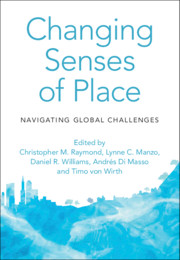Book contents
- Changing Senses of Place
- Changing Senses of Place
- Copyright page
- Dedication
- Contents
- Contributors
- Foreword
- Preface
- Acknowledgements
- Introduction
- Part I Climate Change and Ecological Regime Shifts
- Part II Migration, Mobility and Belonging
- Part III Renewable Energy Transitions
- Part IV Nationalism and Competing Territorial Claims
- Part V Urban Change
- Part VI Technological and Legal Transformations
- Part VII Design and Planning Strategies for Changing Senses of Place
- 22 Local Sense(s) of Place in a Global World
- 23 Urban Experimentation and the Role of Senses of Place
- 24 Domestic Matters
- Part VIII Conclusion
- Index
- References
23 - Urban Experimentation and the Role of Senses of Place
An Illustrative Case from Rotterdam, the Netherlands
from Part VII - Design and Planning Strategies for Changing Senses of Place
Published online by Cambridge University Press: 15 July 2021
- Changing Senses of Place
- Changing Senses of Place
- Copyright page
- Dedication
- Contents
- Contributors
- Foreword
- Preface
- Acknowledgements
- Introduction
- Part I Climate Change and Ecological Regime Shifts
- Part II Migration, Mobility and Belonging
- Part III Renewable Energy Transitions
- Part IV Nationalism and Competing Territorial Claims
- Part V Urban Change
- Part VI Technological and Legal Transformations
- Part VII Design and Planning Strategies for Changing Senses of Place
- 22 Local Sense(s) of Place in a Global World
- 23 Urban Experimentation and the Role of Senses of Place
- 24 Domestic Matters
- Part VIII Conclusion
- Index
- References
Summary
We unpack the role of sense of place in relation to urban experimentation. We conceptualise urban experimentation as a governance approach to foster and activate innovation capacities of communities and places for climate adaptation and institutional trialling of novel approaches. We focus on an urban living laboratory (ULL) as one specific type of urban experiment that has received increasing attention in European cities recently, and use experimentation in ULL as an example to reconsider a dynamic and pluralistic understanding of place. We find that our case study, BlueCity Lab in Rotterdam, NL provides a space where new place-related narratives of change, novel practices and relations emerge, while being embedded within wider, translocal networks of practice. Backed by these insights, we contend that a translocal, pluralised and dynamic concept of place promises to be a valuable lens in order to understand the impacts, manifestations and appropriate responses to global challenges in everyday life.
Keywords
- Type
- Chapter
- Information
- Changing Senses of PlaceNavigating Global Challenges, pp. 301 - 312Publisher: Cambridge University PressPrint publication year: 2021



